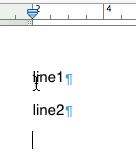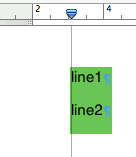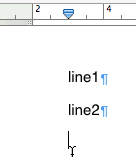Pages 1.0.x: Dumb Word-like behaviour for next paragraph when changing formatting options
Posted by Pierre Igot in: Microsoft, PagesSeptember 20th, 2005 • 4:12 pm
This is the kind of stuff that is all too familiar to long-time Microsoft Word users, but you would have thought that Apple would have done their best to eliminate such glitches in their own Word competitor Pages.
Take a blank Pages document and type two paragraphs of text. Hit the Return key at the end of the second paragraph in order to start a third paragraph, like so:

As you can see, the insertion point (flashing I-beam cursor) is already at the beginning of the third paragraph. Now select the first two paragraphs and change their left indent in the ruler, like so:

Note that you are only changing the left indent for the first two paragraphs. Now once you’ve changed the indent, click at the beginning of the third paragraph again to resume typing. See what happens:

Pages has also changed the left indent for the third paragraph! Good grief. This paragraph was not selected. How come its left indent was changed as well?
As far as I can tell, the only reason for it is some kind of intrinsic flaw in the way Pages works. See, as long as you have not hit the Return key at the end of a paragraph, Pages does not insert the invisible paragraph mark at the end of the paragraph.
But because of this, as long as you haven’t typed anything in the third paragraph, Pages behaves as if this third paragraph did not exist (even though it clearly does), and when you click at the beginning of the third paragraph after having changed the left indent of the first two paragraphs, it also applies this change to the third paragraph, even though it was not selected.
This is highly unfortunate, because it means that, if you want to change formatting options for a portion of your document, you need to make sure that you have already typed something after that portion of the document.
Needless to say, this is not how a person usually works. Once the typist has hit Return at the end of the second paragraph, he assumes that he has started the third paragraph. Indeed, that’s exactly what the visual aspect of the document tells him: the flashing cursor is at the beginning of the third paragraph, so the third paragraph already exists. Of course, if he tried to actually select that third paragraph, he’d see that he’s unable to do so, because there is nothing there yet. But there is something there: the flashing cursor. The fact that the cursor is there is a clear indication that the paragraph already exists—when in fact as far as Pages is concerned, it does not.
This is, in a way, similar to what happens with character formatting within a paragraph. Say you type a word, and then select the word and change the font to italics. When you click after the word to resume typing, the text will be in italics as well. But this makes sense, because, until you’ve typed a space after the word, Pages has no way of telling that the word is complete. The space character acts as the separator between words, and if you select the word without the space after it and change it to italics, after you put the cursor back after the space, the text will not be in italics.
Similarly, it’s the return character that acts as the separator between paragraphs. So once the user has hit the Return key, he naturally assumes that he has clearly indicated that the paragraph is complete. So when he changes the formatting of the paragraph, he doesn’t expect the change to apply to the next paragraph as well! Yet this is exactly what happens.
Like I said, it’s the type of architectural flaw that you’d expect in an application such as Microsoft Word. But not in a brand new word processor designed by Apple!
September 20th, 2005 at Sep 20, 05 | 9:28 pm
Actually, the paragraph *WAS* selected. the only character in that paragraph was the return character. Try it again without selecting the ¶ symbol, and you’ll get the behavior you’re looking for.
Same thing with word, if you select your paragraphs and thee selection hilight goes to the end of the word (rather than the last selected line) you’ll get the behavior you’re looking for.
Normally, i’d say that your behavior rants are right on the money… in this case, i have to disregard it…
September 20th, 2005 at Sep 20, 05 | 10:30 pm
I am afraid you are mistaken. On my machine at least, the last paragraph in a Pages document doesn’t contain a paragraph mark until you press Return at the end of it. This is a significant difference with Word, where there is ALWAYS a paragraph mark at the end of what you are currently typing.
I did not select the ¶ symbol (paragraph mark) for the third paragraph before applying the new left indent, simply because there isn’t a third ¶ symbol. And if you look at my screen shots carefully, you’ll see every clearly that only the first two paragraphs (with their ¶ symbol) are selected.